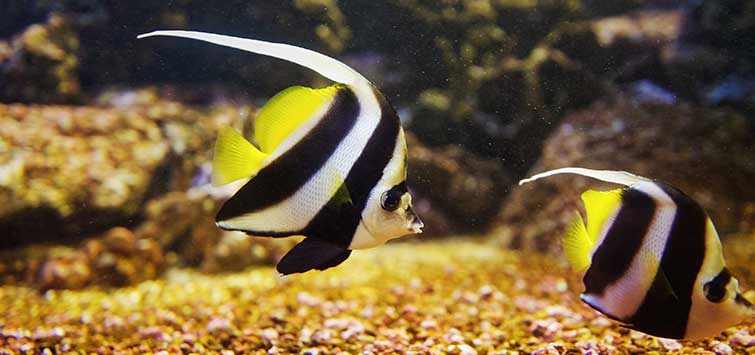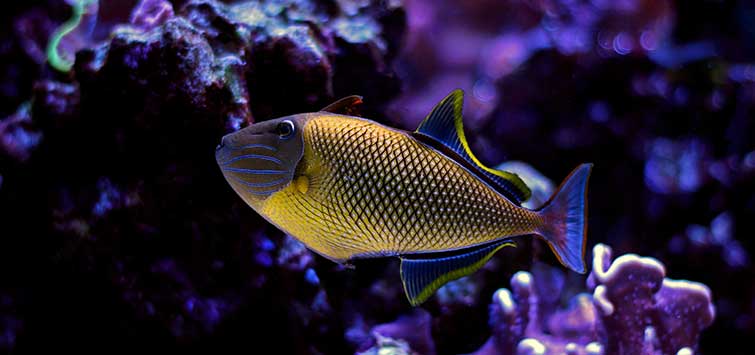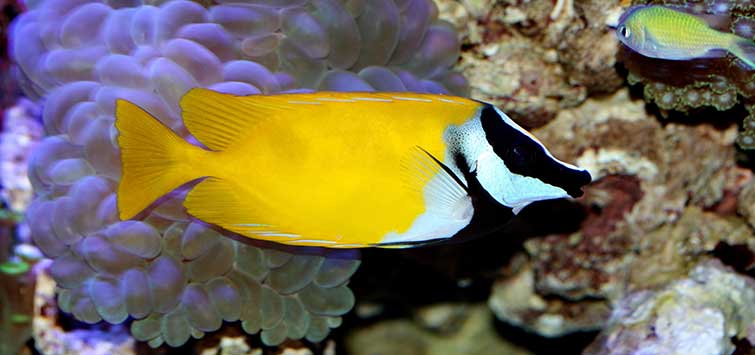Keeping a Single-Species Marine Aquarium
Author: Mark Denaro
Since the early days of the hobby, there have been countless misleading myths related to keeping a marine aquarium. Although overall knowledge about saltwater systems and the technology to maintain them has advanced considerably since then, which has led to many of these myths being disproven, some still persist to this day.
Myth: Marine Aquariums are Harder to Keep than Freshwater Tanks
The idea that a marine aquarium is difficult to establish and maintain remains prevalent among those who have never kept one. The reality is that a saltwater aquarium is not more difficult to keep than a freshwater aquarium, but simply has different equipment requirements and maintenance practices that are unfamiliar to the freshwater hobbyist. There’s also a myth that a minimum size is necessary for marine aquariums and that larger ones are easier to maintain. However, today’s trend toward smaller and smaller saltwater aquariums negates this idea.
Myth: Marine Aquariums Should Be Single-Species
The most persistent myth seems to be that marine fish should be kept as sole specimens in the tank rather than in pairs or groups. I’ve never been able to satisfactorily determine where or when this idea started. While a few species are generally kept in groups, such as green chromis (Chromis viridis), cardinalfish (family Apogonidae), and anthias (subfamily Anthiinae), the vast majority of hobbyists don’t keep species such as angelfish (family Pomacanthidae) or butterflyfish (family Chaetodontidae) in groups, and aquarium shop owners and their employees seldom recommend this practice to their customers. In truth, many popular marine species can easily be kept together in a single-species tank.
The Power of Myth
The possible origin of this misconception may have started out of concern for the large sizes that marine fish have the potential to reach, along with the realization that many saltwater species are territorial. Even in a 125-gallon (473-liter) aquarium (which in the early days of the hobby was considered a gigantic tank), two marine fish—such as emperor angelfish (Pomacanthus imperator)—would not have enough room to establish separate territories. While keeping one emperor angelfish per tank makes sense in this case, extending the same restriction to all other marine species simply doesn’t hold up.
Why Keep a Single-Species Tank?
Keeping only one specimen per species in a saltwater tank is a significant reason why the marine hobby still relies heavily on wild-collected fish. After all, it’s pretty hard to breed a fish when you’re not keeping it with other members of its species. One solution to this dilemma is encouraging more freshwater fish breeders to work on propagating marine species.
Fortunately, in the last few years there has been a surge in the breeding of marine fish by both professional aquarists and home hobbyists. This trend indicates that fewer people are buying into the myth of keeping only one specimen per species in the marine tank, but it’s still a far cry from hobbyists considering purchasing a group of one species rather than single specimen purchases on a regular basis. Working on the wholesale side of the trade, it’s been my experience that most hobbyists are surprised when I suggest buying a pair or a group rather than just one specimen. I also notice that fish retailers frequently order only one specimen of most marine species.
Although more people are breeding marine fish in their home tanks, it’s the professional aquarist who leads the way in reproducing species in captivity. However, the average keepers’ growing interest in captive breeding is still one of the brightest signs for the future of the hobby. The hope is that when they master rearing easily bred species they will move on to more difficult ones. There may even come a time when marine aquarium clubs sponsor breeder award programs much like their freshwater counterparts. When that occurs the marine hobby will have truly arrived.
Single-Species Tank Contenders
Keeping any species in pairs or groups requires appropriately sized aquariums and a level of expertise suited to maintaining the specific fish. Care and maintenance of the species discussed here will not be covered because this article is solely meant to be a guide for which species to keep in a single-species aquarium with the goal of breeding them in captivity. So what fish should be kept in pairs or groups? Let’s go in alphabetical order by common name.
Angelfish
Many Centropyge spp. angelfish can be kept in haremic groups consisting of one male and at least two females. Quite a few species in this genus are sexually dimorphic; the most common distinguishing features for gender identification are the dorsal and anal fins, which are pointed in males and rounded in females. This is true of flame angels (Centropyge loriculus) and other species with a similar body shape, like rusty angels (C. ferrugata). Some species, such as Japanese angelfish (C. interrupta), sport different color patterns for each sex.
If no males are available, start with a group of females because the most dominant individual will undergo a change in sex and become a male in your tank. Genicanthus spp. are sexually dimorphic and should be maintained with a single male and two or more females. I’ve also successfully maintained Apolemichthys and Chaetodontoplus spp. in pairs.
Blennies
Prime candidates for aquarium breeding, most blennies are demersal spawners, meaning they deposit their eggs at the bottom of a body of water. A number of species are sexually dimorphic, with fin length frequently being the main difference between sexes. While there may be a few species that are too aggressive to be kept together, I haven’t found them yet.
Although most experts will tell you not to keep multiple specimens of my favorite species, the sailfin blenny (Emblemaria pandionis), in the same tank, I’ve never had problems mixing them. The key is to have more hiding places than fish, so make sure their tank is stocked with plenty of live rock so they all have multiple spots in which to take cover.
Butterflyfish
If you look at photos of butterflyfish (Chaetodon spp.) in the wild, you invariably see them in either pairs or shoals. Unfortunately, most retailers order only one specimen of each, which makes it difficult to purchase them in pairs. In my experience, butterflyfish simply do better when they are maintained as pairs. The sex of the pair doesn’t seem to matter; any two random individuals that are about the same size will get along together peacefully in the aquarium.
I’ve only seen a few instances over the years where two random fish did not get along. To be clear, I am only referring to the butterflyfish in the genera Chaetodon, Hemitaurichthys, and Heniochus. While members of genera Chelmon and Forcipiger can be kept together, it is more likely that intraspecies aggression will occur, so these are best left in the care of advanced hobbyists.
Eels
There’s never been a problem with keeping eels together in the aquarium, but most people only buy single specimens, and often single specimens of multiple species. Instead, why not try a single-species tank of eels next time? There are at least three documented accounts of ribbon morays (Rhinomuraena quaesita) spawning in public aquaria.
Although this species has the advantage of being sexually dimorphic, it may be difficult to maintain in home aquariums. However, if you work with a smaller species of eel, such as the goldentail moray (Gymnothorax miliaris), you might just be the first hobbyist to spawn them in captivity.
Groupers and Hamlets
Their ultimate size and overall level of aggression make most groupers a difficult choice for the home hobbyist when it comes to housing multiple specimens, but it can be done. Choose one of the smaller species, such as the bluelined hind (Cephalopholis formosa), and keep them in as large a tank as possible. Many species are bred in commercial aquaculture for the food industry, so there is ample information available about raising grouper fry.
Hamlets (Hypoplectrus spp.), the small cousins of groupers, are suitable for most hobbyists. Hamlets are hermaphrodites, and pairs in the wild can spawn several times in the same day while reversing roles. They are somewhat territorial and aggressive toward each other but can be kept together. All specimens should be about the same size and added to the tank at the same time. Extensive rockwork that provides more hiding places than there are fish is essential. I have had success with groups of barred hamlets (Hypoplectrus puella) and butter hamlets (H. unicolor) that were maintained in 65-gallon (246-liter) tanks.
Lionfish and Scorpionfish
Although much maligned in the hobby, lionfish (Pterois spp.) seldom display any intraspecific aggression and are easily maintained in groups. Tank size and filtration capacity will affect your choice of species. Red lionfish (P. volitans) will probably always be the most popular, but they reach large sizes, have large appetites, and need correspondingly large tanks and oversized filtration units. There are numerous smaller species that make better choices for compact tanks.
Scorpionfish are relatively inactive and consequently do not require large aquariums, although they do need an efficient filtration system. Rhinopias spp. scorpionfish are excellent candidates for home breeding. The key to keeping a single-species tank of this group is to acquire similar-sized individuals to prevent larger specimens from eating the smaller ones.
Rabbitfish
Most hobbyists keep rabbitfish (Siganus spp.) as single specimens, despite the fact that they are generally found in pairs or groups in the wild. They are easily maintained herbivores that are popular with reefkeepers because of their voracious appetites for undesirable algae. Indeed, it is not uncommon to see a group maintained together in a dealer’s tank, yet more than one is seldom purchased for the home aquarium.
It seems that the ever-popular foxfaces—a common name given to various species of genus Siganus that feature prominent face stripes—should have been bred in captivity by now. Relatively small by rabbitfish standards, foxfaces do well in groups and should be maintained that way whenever the tank is large enough.
Tangs
While tangs are commonly observed in schools or aggregations in nature, many hobbyists only buy single specimens for the tank. The only species that seems to be an exception is the yellow tang (Zebrasoma flavescens). However, most of the commonly kept tangs do well in groups in the home aquarium. Smaller species, such as convict tangs (Acanthurus triostegus), are particularly well suited for this arrangement. Before acquiring a group, research the size of the species you’re interested in to be sure that your aquarium is large enough to comfortably house them.
Triggerfish
Many shops routinely stock multiple specimens of triggerfish species together in store aquariums. However, with the exception of sexually dimorphic species like the gilded triggerfish (Xanthichthys auromarginatus) they are seldom sold this way. I’ve kept red-toothed triggerfish (Odonus niger) as well as members of the genus Rhinecanthus, including lagoon triggerfish (Rhinecanthus aculeatus), Picasso triggerfish (R. assasi), blackbelly triggerfish (R. verrucosus), and reef triggerfish (R. rectangulus) in groups over the years with good results for the most part.
Individuals should be about the same size and added to the tank at the same time. The key is to carefully observe your new group to make sure everyone is getting along. The last thing you want is for those at the bottom of the pecking order to be killed by their more dominant brethren.
Research and Preparation
Take the time to research any species that interests you, and then do your best to provide a proper diet, excellent water conditions, and an aquascape that meets your selected species’ needs. Once you’ve done that, relax and enjoy watching the fish and noting their intraspecies interactions, which adds another level to the fishkeeping experience—and one that most marine hobbyists haven’t had. I guarantee that your interest in the hobby will grow as you observe their increasingly complex behaviors in a single-species tank.
When you observe their behavior starting to change in ways that indicate they’re coming into spawning condition, start practicing raising live foods so that you’ll be prepared when larvae appear. This would also be the appropriate time to buy or build an egg or larvae collector, with the choice being determined by whether your fish are demersal or pelagic spawners. With proper planning and adherence to a single-species tank setup, you may become a marine fish breeder before you know it.

.png?h=595&iar=0&w=2781&hash=5FD5E69473BCC22199FBFA2FB71B6033)



